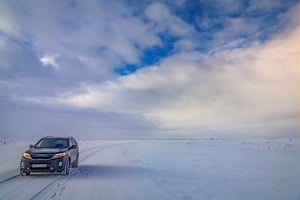 When you think you’ve seen your last snowfall or cold spell, Mother Nature plays another trick on you. Winter weather can make it difficult for our cars to run efficiently or even run at all.
When you think you’ve seen your last snowfall or cold spell, Mother Nature plays another trick on you. Winter weather can make it difficult for our cars to run efficiently or even run at all.
While I like my auto repair garage, I’ve seen it enough. On my last visit, Jeff told me that winter weather does crazy things. Things that never leaked before might start. Batteries, alternators, and other components work very hard during winter and take on significant wear and tear.
Here are some things to watch on your car.
1. Battery and alternator. It’s common knowledge that it takes a good battery to start your car during the winter months. However, what many people don’t know is that the alternator plays a crucial role in maintaining proper battery health. The alternator is like a mini generator. The purpose of it is to recharge your battery after each start of your car. On a regular winter day, your alternator may need up to 20 minutes of drive time to recharge it. But on a frigid day, it may need even more time.
Here are the warning signs for a bad alternator.
- Battery image. If you see a battery image on your dashboard, this doesn’t mean you have a battery problem. It’s an alternator problem. Depending on the severity of the problem, the light may flicker on and off. Consider shutting down some systems in your car that may not be necessary, such as heated seats. When this light comes on and stays on, it means it’s having a tough time meeting your vehicle's electrical needs.
- Dim or flickering lights. Because the alternator can’t keep up with your car’s electrical needs, you may see dim or flickering headlights. You may also see multiple dashlights flickering on and off.
- If you have a relatively new battery and suddenly it’s dead, you may have an alternator problem.
- Weird sounds are coming from under the hood. A growling or whining sound may indicate there is a problem.
2. Tires and other components. Unfortunately, it’s tough for road crews to keep up on repairing potholes. It seems like they pop out of nowhere. Unsuspectingly, hitting a pothole can be scary and expensive. If you’ve recently hit a pothole, here are some things to watch for:
- Tire puncture;
- Bent rims;
- Suspension damage;
- Steering out of alignment; and
- Exhaust system damage.
For tips on how to avoid potholes, check out my blog, “Watch out for that pothole! 5 tips to avoid them.”
Please note that cold air can cause tires to lose tire pressure. It’s dangerous to drive with under-inflated tires. Under-inflated tires can lead to tire failure, poor handling, and buying tires more frequently. Consider checking your tires regularly with a tire gauge or keep an eye on your car’s monitoring system.
3. Fluids. Fluids such as oil and antifreeze are critical for our cars. As temperatures drop, fluids thicken making it difficult for your vehicle to run efficiently. Mysterious leaks due to cold weather can cause a critical failure to an essential component of your car. If you find fluid on your garage floor, pay attention to what color it is.
- Red – transmission or power steering fluid
- Green – antifreeze
- Blue – windshield washer fluid
- Brown – motor oil or brake fluid
Based on the make and model of your car, colors may vary.
4. Windshield Wipers. Windshield wipers are a crucial component on your car. Especially during the winter months when experiencing snow, sleet, freezing rain, and rain. Cold weather can cause the rubber to become brittle and tear or crack.
When cleaning your windshield, use caution when scraping and cleaning around them. If your wipers are stuck to the windshield, consider turning your defrost on to loosen the ice and snow. A torn wiper blade can make for a miserable commute.
Lastly, consider changing windshield wipers every 6-12 months.
To learn more about the different types of windshield wipers, check out my blog, “No more mistakes when replacing windshield wipers.”
5. LCD screens. If your car is equipped with an LCD screen for the infotainment system cold weather can cause it to run slow or not appear at all. Unfortunately, there’s nothing you can do other than let your car warm up. I must admit, it isn’t easy to turn on the heat when nothing appears on the screen.
6. Paint. Road salt does a great job of keeping our roadways clear and safe for drivers. However, it can damage your car’s paint and underlying metal components. Certain types of salt can cause paint to chip. Salt can attack dents and dings and cause the exposed metal to rust more quickly. Depending on the weather, my wife and I try to wash our cars every week.
Do you have any suggestions or information you’d like to share? I’d love to hear from you. Please share them in the box below.
Source:
http://kiadealersnj.com/what-winter-does-to-your-car-and-how-to-stop-the-damage/
http://knowhow.napaonline.com/spot-alternator-problems-winter/
https://www.pepboys.com/auto-care/maintenance/car-leaking-fluid





